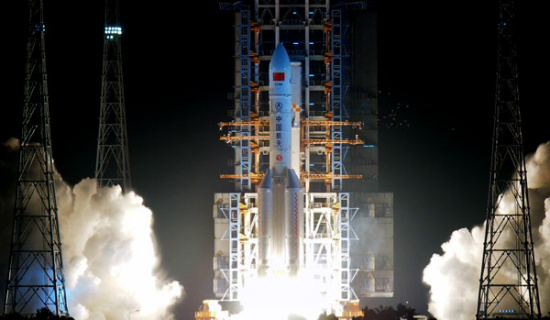
The Long March 5 blasts off from Wenchang Space Launch Center in South China's Hainan Province, Nov. 3, 2016. (Photo by Su Dong for China Daily)
Chinese engineers have determined what caused the failure of the second flight of China's largest carrier rocket, a Long March 5, in July and have come up with corrective solutions, according to the State Administration of Science, Technology and Industry for National Defense, which oversees the program.
The administration said in a statement on Monday on its website that a number of simulations, calculations and ground experiments were carried out and results point to structural abnormalities inside the turbine exhaust device of one of the first stage's liquid oxygen/liquid hydrogen engines.
The abnormalities caused a sudden loss of engine thrust, depriving the rocket of lift, the statement said.
So far, engineers have carried out several ground ignition tests on the modified engine and concluded that the changes are effective, it said, adding that a third Long March 5 is under construction and will be launched this year. The statement did not say what that rocket's payload will be.
If the third flight goes well, then the rocket's fourth mission will send the nation's Chang'e 5 lunar probe to the moon, the administration said.
Scientists and engineers are pinning their hopes on the Long March 5 and its variants because the space industry wants to use them to ferry the first Chinese space station into orbit, as well as send probes to Mars and Jupiter.
The July failure affected the country's space agenda as the government had to postpone several key missions, including the Chang'e 5 expedition, which will send a rover to the moon and return with surface samples.
China's space launch activities were suspended for nearly three months after the failure. They resumed at the end of September.
The strongest and most technologically sophisticated rocket built by China, the Long March 5 has a liftoff weight of 869 metric tons, a maximum payload of 25 tons to a low-Earth orbit, or 14 tons to a geosynchronous transfer orbit. Its payload capacity is about 2.5 times greater than any other Chinese rocket.
The giant rocket's first flight was in November at the Wenchang Space Launch Center in Hainan Province.
Engineers have started assembling the first prototype of the Long March 5B, a variant that will be tasked with lifting the Chinese space station's core module and other parts, the China Manned Space Agency said last month.
That rocket is expected to make its first flight around June next year to verify its reliability and capabilities, the agency said.


















































